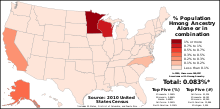 | |
| Total population | |
|---|---|
| 363,565 (2023)[1] 0.11% of the U.S. population (2022) | |
| Regions with significant populations | |
| California (Fresno, Sacramento, Stockton, Merced[2]), Oklahoma (Tulsa), Wisconsin (Wausau, Sheboygan, Green Bay, Fox Cities, Madison, Milwaukee), Minnesota (Minneapolis–St. Paul), North Carolina (Charlotte, Raleigh, Hickory), New York (New York City), Alaska (Anchorage), Iowa | |
| Languages | |
| Hmong, American English, some Mandarin, some Lao, some Thai, some Vietnamese | |
| Religion | |
| Miao folk religion, Buddhism, Shamanism, Christianity[3] | |
| Related ethnic groups | |
| Miao people |
Hmong Americans (RPA: Hmoob Mes Kas, Pahawh Hmong: "𖬌𖬣𖬵 𖬉𖬲𖬦 𖬗𖬲", 苗族) are Americans of Hmong ancestry. Many Hmong Americans immigrated to the United States as refugees in the late 1970s, with a second wave in the 1980s and 1990s. Over half of the Hmong population from Laos left the country, or attempted to leave, in 1975, at the culmination of the Laotian Civil War.
During this period, thousands of Hmong were evacuated or escaped on their own to Hmong refugee camps in neighboring Thailand.[4] About 90% of those who made it to refugee camps in Thailand were ultimately resettled in the United States. The rest, about 8 to 10%, resettled in countries including Canada, France, the Netherlands, and Australia.
According to the 2021 American Community Survey by the US Census Bureau, the population count for Hmong Americans was 368,609.[5] As of 2019, the largest community in the United States was in the Minneapolis–St. Paul metropolitan area.[6] Hmong Americans face disparities in healthcare, and socioeconomic challenges that lead to lower health literacy, median life expectancy, and per capita income.[7]
- ^ "US Census Data". U.S. Census Bureau. Retrieved September 21, 2024.
- ^ "Top 10 U.S. metropolitan areas by Hmong population, 2019". April 29, 2021. Retrieved December 3, 2023.
- ^ "Hmong Americans". Cultural Aspects of Healthcare. The College of St. Scholastica. 1996. Archived from the original on June 30, 2013. Retrieved February 15, 2013.
Primary religious/spiritual affiliation. A recent study found that 75% of Hmong people practiced traditional religion which is animistic. Many Hmong also practice Buddhism or Christianity with membership to various churches such as Catholic, Missionary Alliance, Baptist, Mormon, and others.
- ^ "Hmong Timeline". Minnesota Historical Society.
- ^ "B02018 ASIAN ALONE OR IN ANY COMBINATION BY SELECTED GROUPS – 2021: 1-year estimates Detailed Tables – United States". United States Census Bureau.
- ^ Budiman, Abby (April 29, 2021). "Hmong: Data on Asian Americans". Pew Research Center's Social & Demographic Trends Project. Archived from the original on June 13, 2021. Retrieved August 6, 2021.
- ^ Vang, Kao Kang Kue M. (July 28, 2019). Culture and Health Disparities: Hmong Health Beliefs and Practices in the United States. Sigma Global Learning Excellence 2019. STTI. Archived from the original on March 21, 2021. Retrieved April 23, 2020.
